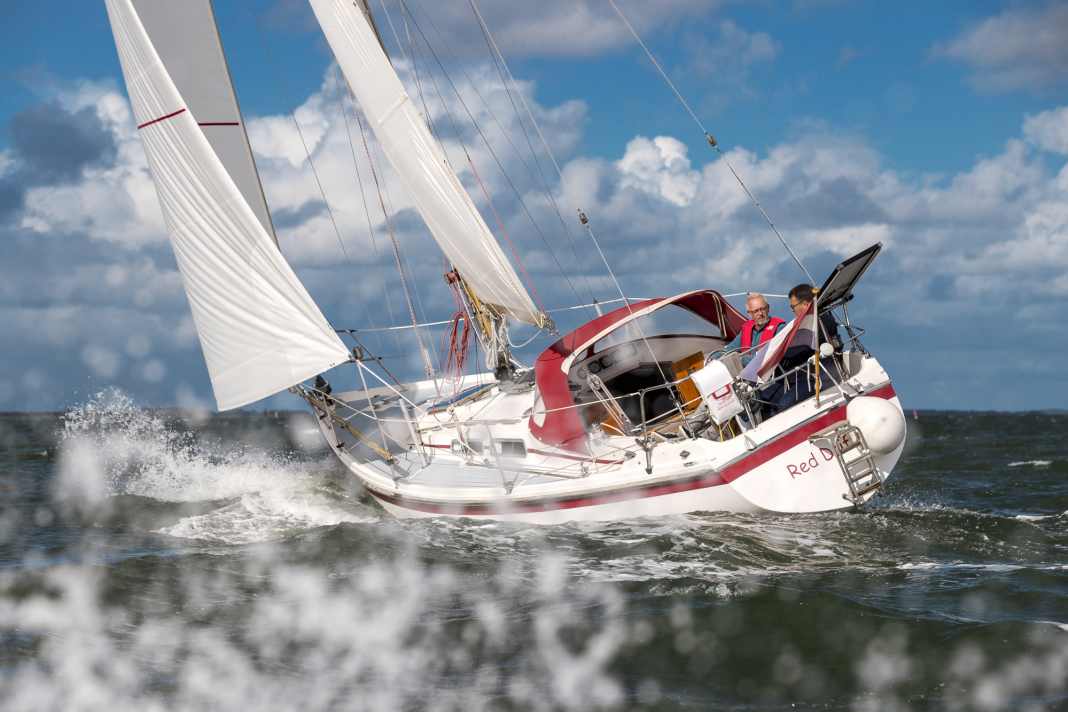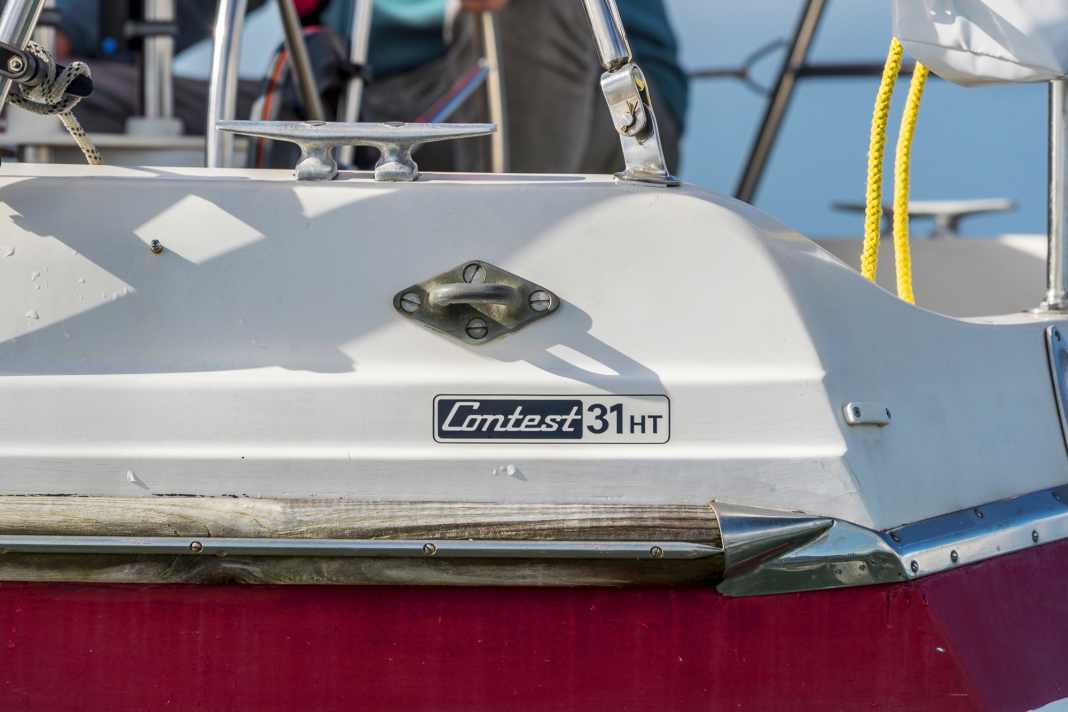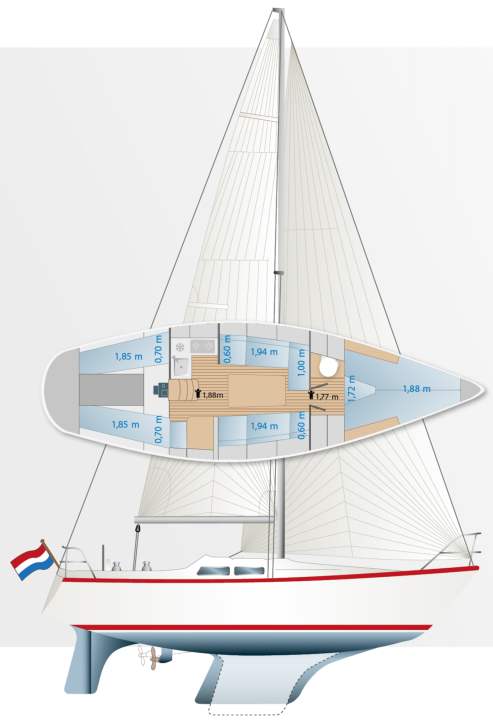





- Many older contests struggle with osmosis
- Screws often laminated over from the inside
- Good-natured sailing characteristics
- Model history and design
- Market situation
- Pay attention to this
- The measured values for testing the Contest 31 HT
- The Contest 31 HT in detail
- Price and shipyard
- YACHT rating of the Contest 31 HT
On average, people grow two and a half centimetres taller every decade. And from this perspective, a bunk that is 188 centimetres long from 1974 is exactly within the range of what is common today: beds have to be two metres long to meet general requirements. The Contest 31 HT was designed over 50 years ago, and the ergonomic standards of the time were different. The bunks and standing heights are correspondingly lower. So much in advance.
What was also different back then was the standard of construction. This becomes clear when you descend into the salon. There you enter a time capsule. 50 years of boatbuilding between today's modern, light-coloured interiors and what Contest produced back then. The wooden grain running through the locker lids, the consistent utilisation of every little corner as storage space, the solid fittings that still work today, handles everywhere.
Also interesting:
But there is also a certain narrowness and darkness that the wood radiates. Your gaze wanders around. Everything looks as it did on the first day. In terms of the quality of the surfaces, the boat could have been delivered yesterday. But there are always elements that look like something from a technology museum: The old VHF radio, an echo sounder with a red light-emitting diode and some navigation gizmos whose function is no longer clear to late-born people.
Many older contests struggle with osmosis
Owner Martin van der Toorn thinks that's great: "I even had the spark repaired and it works. You're just not allowed to use it any more because it doesn't have a DSC." He also had the original Eno cooker serviced and then re-enamelled. "It just fits in here." Just like the switch panel with the pull buttons. Mind you, all of this is half a century old. It would probably be difficult to buy an electronic device today that has been in service for so long. Will the same apply to the boats themselves? We'll have to wait and see.
You don't have to wait for the Contest. Even after five decades, it still works without complaint. Of course, repairs have been necessary over the years. "There was a crack on the skeg when I bought it. I had to laminate something. And the old engine gave up the ghost just before we wanted to go out on the North Sea. We then had a new one installed." That's the good thing about a solid boat: even after many years, major investments are worthwhile because the substructure is durable enough to benefit from it for a long time to come.
Many older contests struggle with osmosis. Repairing the bladder disease is not that complicated. If you have a little manual dexterity, you can even look for a boat with osmosis, buy it cheaply and carry out the repair yourself.
Older Contests are considered to be very solid boats with particularly thick laminates. This also applies to the 31 HT. Unlike other contests, however, the keel of the 31 HT is not laminated to the hull as a single piece and ballasted from above, but is bolted under the hull using keel bolts. The transition from keel to hull is a critical point, as with any other boat of this design. It is important to pay close attention to this when buying, especially in the version with the deep keel.
Screws often laminated over from the inside
Are there any hairline cracks on the backing plate of the aft bolts? Are there any signs of leakage? This is not always easy to see, because Contest has always laminated everything on the inside. This makes for leak-proof boats, but also hides any problems. This is also the case with the railing feet. They are screwed into wooden panels laminated underneath the deck with wood screws. It doesn't take much imagination to visualise what the wood will look like after all these years. The problem is that it's difficult to get at it. The wooden panels have to be exposed from the inside, after which the repair is simple: an aluminium or stainless steel plate from underneath, a few screws and some MS polymer. That's it.
The same applies to the Genoa rails. These are bolted through with screws. The whole thing was then also laminated over from the inside. As long as the nut holds in the laminate, everything is fine. Then the screw can be unscrewed on the outside and the rail can be reinserted in a sealing bed. But don't worry if one of the nuts turns freely in the laminate. Then you have to grind from below to get to the nut.
Finally, the mast base was also laminated over. This time, however, from the outside. There is a thick wooden plate in the mast base. The mast base screws are screwed into this. If lateral forces are applied when the mast is set, the screws can easily come loose. Water can then get into the mast base and soften the wood. However, all of these things are more of a nuisance than a problem if you know how to use an angle grinder, resin and hardener. Nobody would have thought at the time that the solutions found back then would prove so successful that they would still be reported on 50 years later.
The durability of a contest can be tested on the Grevelinger Meer off Herkingen. Fresh and gusty 20 knots of wind provide ideal conditions. This immediately reveals a dilemma of the IOR designs. Large sail area was penalised by the formula. As a result, the rear sail is usually rather small and the surface area is taken up by the genoa. Owner Martin: "I ordered a smaller headsail. The huge lobe wasn't practical and working on the winches was really difficult. Now we have a bit too little power when there's very little wind, but as soon as it blows a bit, we're travelling well." For the test, that means full sail. Between the gusts, it works well, at least if you don't go very high into the wind. But if the wind picks up again, the mainsail has to be open. The ship always remains very confident at the helm, with no sunshade behaviour, only the heeling increases considerably.
Good-natured sailing characteristics
The sailing characteristics themselves are incredibly good-natured, although it says HT for half-tonne, the Contest has left the bitchy unpredictability of IOR racing goats on land. Here, 50 per cent ballast is effective and ensures composure. And if the gust does turn out to be stronger than expected, both sheets are not far away. However, the helmsman has to reach around his work equipment to get hold of the mainsheet. This is certainly easier in the version with a tiller, as this was also available on the 31 HT. It goes back. The waves push the narrow stern back and forth quite a bit. The Contest tends to fiddle a little. That means careful steering, which is very easy and direct.
So what kind of boat is the Contest 31 HT? Heavy and solid and at the same time with a lot of cloth on it with a sporty allure. Well built but with many small points that owners need to improve. If you are interested in a Contest, you should definitely also appreciate the manual side of ownership and be able to spare the time that this requires, even in winter. "It took us a few years to get everything tight. But that's how you get to know your boat, the connection becomes closer. However, I also enjoy working on the boat. It's a good balance to my job as a programmer," reports owner Martin.
The joy is all the greater when everything works on a family cruise in summer. This joy also continues when the bad weather catches you, then the Contest has the answers: well protected, deep cockpit, good-natured sailing characteristics and pleasant behaviour in waves. Only the huge headsail then needs to be tamed. Owner Martin's decision to switch to a smaller foresail certainly makes sense. After consultation with the sailmaker, a longer boom and a little more area in the main would also be an option. This would make it possible to reduce the sail area by reefing the main.
Of course, there are also 31s on the market that are fully refurbished. There will be less work involved, but the boats are more expensive. Ultimately, it's a question of your own taste and budget as to whether it should be a DIY boat or a finished boat. However, the Contest always offers enough substance to allow you to take a closer look at it, for example during a refit. Alternatively, there is also the Victoire 933 or the Friendship 33 on the market, although the latter is newer. The legendary Contessa 32 is also an alternative to the Contest.
Model history and design
The Contest 31 was built in solid laminate. Sandwich? Not a chance. The construction is heavy and provides little insulation, but there are no soft spots. But there is osmosis. This is not a problem, the hulls are sufficiently thick and can easily be refurbished by the owner. There are two draught variants, saildrive or shaft, as well as a version, the AK, with two single aft berths.
Market situation
As quite a lot of them were built and the 31 HT is a typical intermediate ship in the owner's career, there are always some available, mostly in the Netherlands. The important question is: osmosis, yes or no, and new engine, yes or no. The price goes up or down depending on this. What has the seller already done, what is still to be done? An expert opinion can therefore be very useful.
Pay attention to this





The skeg cracks at the transition to the hull over time, in which case it needs to be laminated. The original hatches usually leak. They can be repaired or replaced, depending on taste. The windows also leak.
The measured values for testing the Contest 31 HT



The Contest 31 HT in detail

Technical data of the Contest 31 HT
- Design engineer: Dick Zaal
- Torso length: 9,40 m
- Total length: 9,50 m
- Waterline length: 7,72 m
- Width: 3,15 m
- Draught/alternative: 1,45/1,75 m
- Mast height above WL: 13,50 m
- Theoretical torso speed: 6.75 Kn
- Weight: 5,0 t
- Ballast/proportion: 2,5 t/50 %
- Mainsail: 18,2 m2
- Furling genoa (106 %): 37,5 m2
- machine (Volvo P.): 23 kW/30 hp
- Fuel tank: 100 l
- Fresh water tank: 230 l
- Holding tank: not available
Price and shipyard
- Base price 1972: 20.000 €
- Used price: 18.000-35.000 €
Shipyard
Contestyachts, contestyachts.com
YACHT rating of the Contest 31 HT
The boat is a lot of fun and safe. Plenty of storage space below deck, but tight berth dimensions
Design and concept
- + High ballast content
- - Small cockpit bilge pump
Sailing performance and trim
- + Amazingly direct control
- + Wide Traveller
Living and finishing quality
- + Very solid construction quality
- - Berth dimensions very tight
Equipment and technology
- + Generous fittings
- + Large tanks

